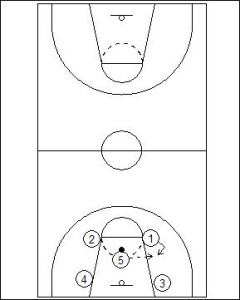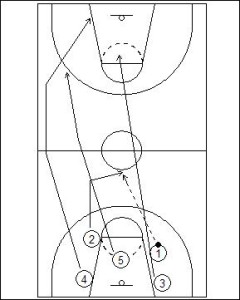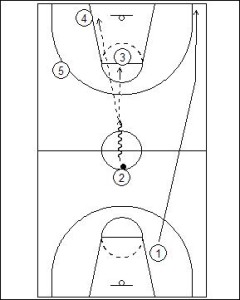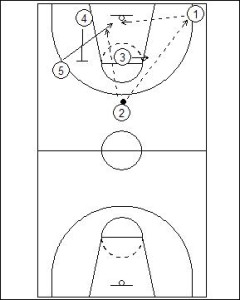Primary Transition: Sideline Overload
The Sideline Overload Primary Transition is a very functional tactic in moving the ball from one end of the floor to the other. The Sideline Overload Primary Transition has a number of benefits that help increase speed of play and possible high percentage scoring opportunities close to the basket out of the transition offense phase. A good primary transition is necessary for any decent basketball team, and the Sideline Overload Primary Transition helps provide a vehicle for creating scoring opportunities not just move the basketball.
One of the most significant benefits of the Sideline Overload Primary Transition is the movement of the Shooting Guard within the offense. The shooting Guard once the outlet has been created to the Point Guard creates a lead to the middle of the floor. This movement is executed with the Shooting Guard never stopping to receive the pass, but rather catching the ball on the run and from a passing position over the shoulder of the Two Guard. The execution of this aspect of the offense will need to be practiced at length to ensure the technical and tactical skills required can be performed correctly and at pace.
A point of note about this tactic is that the benefit of practice is not only for the player within the Shooting Guard position. The Point Guard or outlet player will also benefit from this intense practice prospect, as they will be able to determine when the player is being guarded and as a result when the pass is not possible and at what point the risk to ‘push’ the pass is reasonable.
Another of the significant positive aspects about the Sideline Overload Primary Transition is the running of two offensive players into or at the very least very close to the keyway (Four and Three in the diagrams below). This is a somewhat uncommon transition element with regards to both spacing and overloading one side of the floor to create fruitful prospects if the ball is reversed later on in the offensive play.
The placement of the two players close to the basket allows for not only a myriad of interior player scoring tactics (high low passing) but also provides good rebounding position for early shots within the transition. This indeed a very rare aspect of most primary transition offences.
The final aspect worth noting is the placement of the first lane runner on the baseline. This is a very important position and one that is as much about place for the offense as the defence. By having a player in this position the early defensive positioning of players will mean the defence is pulled close to the basket and condenses in or tightly around the keyway. This aspect will provide further opportunities for the offences and in general increase scoring percentages as players will be able to move closer to the basket before attempting a shot.

Rebounder (Five) passes ball to outlet on wing.
One (1) receives ball from lead away then back to ball.

Weak side guard flash cuts to split-line on jump circle (Two).
One (1) passes to two (2).
Strong side forward runs to free throw/split-line. The tries to seal defensive player on high side to create opportunity for lob pass.
Rebounder to weak side 3/45 (Five).
Weak side forward runs wide lane to cut into low block (Four).

Option 1: Two (2) receives ball and looks to lob pass to Three (3).
Option 2: Two (2) receives ball and looks to pass to Four (4) cutting to basket.
Option 3: Two (2) dribbles to point position.
One (1) run to long corner on rebound side.

Example Secondary Transition
Four (4) sets up screen for Five (5).
Three (3) moves to high post opposite to screen action.
Five (5) cuts off screen towards basket.
Option 1: Two (2) passes ball to Five (5) on cut to basket.
Option 2: Two (2) passes ball to One (1) who passes ball to Five (5) on cut to basket.








Leave a Reply